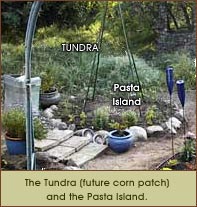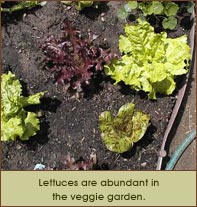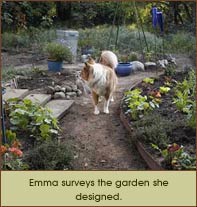Guest post by Felicia Friesema
Gardening, as you may well know, is a constantly changing learning process that tests our willingness to give in to the natural world, to submit ourselves wholeheartedly to a process that denies us what we think we want in favor of what the garden wants. You want fresh zukes? Battle powdery mildew then. Dreaming of a leaning tower of tomatoes? Gotta squash the caterpillars early on. You get the idea. What we want isn’t always what we get. But sometimes, Nature smiles on us and gives us something bigger and more unusual than ever before. For me, it took a dog playing in the grass for Nature’s light bulb to go off over my head.
Emma, our persnickety canine, is queen of all she surveys. Aside from a small, community-style, garden plot for summer veggies, the backyard was hers to rule with an iron paw. Stray cats, opossums, and curious crows dared not enter the domain for fear of her wrath. Our own lack of interest in clearing out old Bermuda grass from our clay-based soil meant that it stayed that way for some time, untouched, untrimmed, and often times, unloved.
 It’s a mid-sized yard, about 50 feet long and 35 feet wide. My community gardening days back in the city of Baltimore had taught me how to cram as much as I could into a 6′ by 10′ garden plot as I could. The result was a jungle of tomatoes, cukes, zukes, and herbs that you couldn’t walk through by mid-July. Moving to a house with a backyard in sunny Southern California opened many doors garden-wise, but I stuck to what I knew and carved out a square plot for myself among the weeds. And then I saw Emma walking through the grass.
It’s a mid-sized yard, about 50 feet long and 35 feet wide. My community gardening days back in the city of Baltimore had taught me how to cram as much as I could into a 6′ by 10′ garden plot as I could. The result was a jungle of tomatoes, cukes, zukes, and herbs that you couldn’t walk through by mid-July. Moving to a house with a backyard in sunny Southern California opened many doors garden-wise, but I stuck to what I knew and carved out a square plot for myself among the weeds. And then I saw Emma walking through the grass.
The area around the plot was often referred to as the tundra. And through this tundra, Emma had carved a winding path through the weeds and grasses that led to the back of the yard and around the garage. I realized then that she had done the hardest part for me already. All I had to do was follow her guidelines and I would have a series of well-defined beds and borders.
I started with a centerpiece. As Emma entered the yard, she would make a wide turn to the right before swinging left to head toward the back. This left a natural curve that had me thinking it was part of a circle. Off of that curve, I constructed the first garden element: the Pasta Island.
 The Pasta Island is a raised circular bed, about 5 feet across, constructed of reclaimed stones from and old demolished patio, that sat cupped on the left side of the curve of Emma’s path. The stones are actually a very lucky find under a pile of old leaves. Their texture and shape meld perfectly with the lines of Emma’s path. Being a themed veggie patch, the island contains tomatoes, onions, basil, oregano, parsley, and bell peppers.
The Pasta Island is a raised circular bed, about 5 feet across, constructed of reclaimed stones from and old demolished patio, that sat cupped on the left side of the curve of Emma’s path. The stones are actually a very lucky find under a pile of old leaves. Their texture and shape meld perfectly with the lines of Emma’s path. Being a themed veggie patch, the island contains tomatoes, onions, basil, oregano, parsley, and bell peppers.
With the centerpiece finished, I added two more semi-circles leading up to the Island and a long wavy raised bed to the right, leaving Emma’s path intact and adding greatly to the overall appeal. There wasn’t a straight line anywhere. The soil was easier to amend, now that I had easy access to it via the path.
It’s like a domino design effect. Once the main elements, the island, the semi circles, and the right hand wave border, were installed, the rest of the garden opened up to me like a massive sunflower. Suddenly there was space for a patio made from reclaimed concrete paving stones. And next to the patio the was room for a mini perennial Mediterranean garden full of rosemary, oregano, lavender, thyme, tarragon, and a bay laurel tree in a large pot.
 Emma took to the “new” paths right away, speeding through the veggies as though it were an obstacle course designed just for her. The natural shapes keep her out of the veggie beds as well, since we’re not intruding on her own backyard rhythms or making her redefine her territory. And at last my eyes are comforted by gentle, meandering curves, no longer confined to rigid rows. The veggie garden is now a decorative garden in its own right, easily adaptable to crop rotations and soil amendments and pleasant enough for a summer night glass of wine shared by the light of citronella candles.
Emma took to the “new” paths right away, speeding through the veggies as though it were an obstacle course designed just for her. The natural shapes keep her out of the veggie beds as well, since we’re not intruding on her own backyard rhythms or making her redefine her territory. And at last my eyes are comforted by gentle, meandering curves, no longer confined to rigid rows. The veggie garden is now a decorative garden in its own right, easily adaptable to crop rotations and soil amendments and pleasant enough for a summer night glass of wine shared by the light of citronella candles.
Now if I could only teach Emma how to dig up weeds.
All Photos courtesy of Felicia Friesema
Felicia Friesema is a community garden advocate and Development Coordinator for the YWCA of San Gabriel Valley. Her dedication to community gardening extends to her own backyard, which she has turned into a community garden for her friends, allowing them to plant any vegetables and flowers they wish.